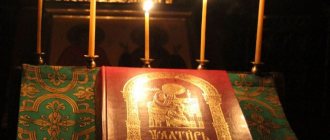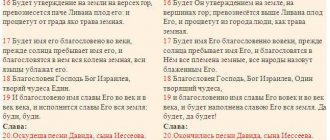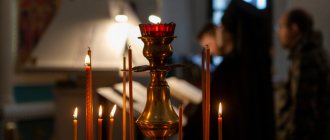Today there is a great increase in interest in the Orthodox faith. And this is probably due to the fact that people began to seek God. After all, life with its sharp turns very often leads them to a real dead end. And then everyone begins their own path to God. In this case, prayer becomes the main companion. She, like a lamp in the darkness, begins to illuminate the path. You just need to learn how to use and understand it correctly. The most powerful liturgical book - the Psalter and Kathisma - will help every believer in this. And if everything is clear with the first concept, then the second causes genuine surprise to many. Accordingly, inexperienced believers are interested in the question: kathisma - what is it? Let's talk about everything in order.
Composition and method of reading
The Psalter is divided into 20 kathismas in such a way that all kathismas are approximately the same length. Therefore, different kathismas contain different numbers of psalms. The 18th kathisma contains the most psalms; it includes 15 psalms (psalms 119 - 133) [2], called “songs of degrees.” Kathisma 17, on the contrary, contains only one psalm, divided into 3 parts. This is Psalm 118, or the so-called. “Immaculate”[3]. In addition, this kathisma is divided into two halves: between the 93rd and 94th verses the word “Wednesday”
, i.e. middle.
Each kathisma, in turn, is divided into three parts, called “articles”
(Greek στάσις -
standing
) or
“glory”
. This second name comes from the doxology, which is usually read between glories:
Glory to the Father, and the Son, and the Holy Spirit, now and ever, and unto ages of ages. Amen. Alleluia, alleluia, (alleluia,)[4] glory to Thee, O God. (Three times). Lord, have mercy (three times). Glory to the Father, and the Son, and the Holy Spirit, now and ever, and unto ages of ages. Amen.
Thus, the division of the Psalter into kathismas can be represented by the following table:
| Kathisma | 1 Glory | 2 Fame | 3 Glory |
| I | 1-3 | 4-6 | 7-8 |
| II | 9-10 | 11-13 | 14-16 |
| III | 17 | 18-20 | 21-23 |
| IV | 24-26 | 27-29 | 30-31 |
| V | 32-33 | 34-35 | 36 |
| VI | 37-39 | 40-42 | 43-45 |
| VII | 46-48 | 49-50 | 51-54 |
| VIII | 55-57 | 58-60 | 61-63 |
| IX | 64-66 | 67 | 68-69 |
| X | 70-71 | 72-73 | 74-76 |
| XI | 77 | 78-80 | 81-84 |
| XII | 85-87 | 88 | 89-90 |
| XIII | 91-93 | 94-96 | 97-100 |
| XIV | 101-102 | 103 | 104 |
| XV | 105 | 106 | 107-108 |
| XVI | 109-111 | 112-114 | 115-117 |
| XVII | 118:1-72 | 118:73-131 | 118:132-176 |
| XVIII | 119-123 | 124-128 | 129-133 |
| XIX | 134-136 | 137-139 | 140-142 |
| XX | 143-144 | 145-147 | 148-150 |
Psalm 151, found in the Greek and, accordingly, Slavic Bibles, adjoins the end of the 20th kathisma; in temple worship, however, it is not used.
Kathisma: what is it?
The liturgical section of the Psalter is called kathisma. This word is translated from Greek as “to sit.” That is, while reading it at the service, it is not necessary to stand on your feet. You are allowed to sit down. There are a lot of kathismas in the holy book of the Orthodox. It is very important to understand that the Psalter is divided into as many as 20 similar sections. Kathisma 17 is the smallest. It consists of only one Psalm 119, called “Immaculate.” In turn, it is divided into three parts.
But the biggest kathisma is the eighteenth. It includes 15 psalms: from 119 to 133. The Psalter is read by kathisma, where each part is called statia (from Greek “chapter”, “subsection”) or glory. In turn, it may consist of one or more psalms.
Liturgical use
In the temple
For liturgical use, the Psalter is distributed between Vespers and Matins in such a way that all 20 kathismas are read during the week. In the normal case, kathismas are read in a row, one at Vespers, two at Matins, and the following considerations are taken into account:
- The week begins on Sunday, so the first kathisma is read at Sunday Vespers, that is, on Saturday evening;
- On a holiday, if the All-Night Vigil was served the day before, kathisma is not allowed at Vespers. Since the Rule requires a vigil to be held on the eve of every Sunday, there is no kathisma on Sunday evening.
- The 17th kathisma, “blameless,” should have been read on Friday morning. Since, however, on weekdays this kathisma is already read at the midnight office, it (together with the 16th kathisma preceding it) is transferred to Saturday.
Accordingly, the distribution of kathismas during normal periods of the year
looks like this (vespers in this table refers to
the liturgical
day, i.e., for example, Sunday vespers is vespers on Saturday evening):
| Day | Vespers | Matins |
| Sun | 1 | 2, 3, (17)[5] |
| Mon | — | 4, 5 |
| W | 6 | 7, 8 |
| Wed | 9 | 10, 11 |
| Thu | 12 | 13, 14 |
| Fri | 15 | 19, 20 |
| Sat | 18 | 16, 17 |
At vespers of a holiday that has a polyeleos or higher, the ordinary kathisma is left out, and instead of it the same first kathisma is sung as at Sunday vespers, but only its first article (the so-called “Blessed is the man”[6]). At Vespers on the eve of the great feasts of the Lord, there is no kathisma at all (with the exception of Saturday evening, when the 1st kathisma is prescribed, and Sunday evening, when “Blessed is the man”). Kathismas are always ordered at Matins, even on great holidays (with the exception of Easter week, which has a special liturgical charter).
During the autumn-winter period of the year
(from September 22 to December 20 and from January 15 to Saturday in the Week of the Publican and Pharisee) the order of reading the kathismas changes slightly. Kathisma, placed on weekdays at Vespers, is transferred to Matins of the same (calendar) day, thus, at Matins 3 kathismas are read, and at Vespers - always kathisma 18. At the same time, on Friday and Saturday at Matins there are still two kathismas, on Saturday evening there is still 1st kathisma, and on Sunday evening there is still no kathisma.
A special schedule for reading kathismas is used during Lent
. During this period, the Psalter is read not once, but twice during the week. To achieve this goal, kathismas are read not only at Vespers and Matins, but also during the hours, after the usual psalms. During all weeks of Lent, except the fifth, the following schedule is used:
| Day | Vespers | Matins | 1 hour | 3 Hour | 6 Hour | 9 o'clock |
| Sun | 1 | 2, 3 | — | — | — | — |
| Mon | — | 4, 5, 6 | — | 7 | 8 | 9 |
| W | 18 | 10, 11, 12 | 13 | 14 | 15 | 16 |
| Wed | 18 | 19, 20, 1 | 2 | 3 | 4 | 5 |
| Thu | 18 | 6, 7 ,8 | 9 | 10 | 11 | 12 |
| Fri | 18 | 13, 14, 15 | — | 19 | 20 | — |
| Sat | 18 | 16, 17 | — | — | — | — |
On the fifth week
On Thursday of Great Lent the Great Canon of St. Andrey Kritsky. In view of this, the schedule for this week has been rearranged in such a way that there is only one kathisma for Thursday morning. There is also an alternative schedule for those cases when the Annunciation falls on Thursday and the reading of the Great Canon is moved to Tuesday.
On Holy Week
The Psalter is read once, from Monday to Wednesday inclusive, after which the reading of the kathismas is abandoned completely (with the exception of the Immaculate Ones, sung with praise at Matins on Holy Saturday).
On Holy Week
Kathisma is not allowed.
In home (cell) prayer
The Psalter is also widely used in home or cell prayer. It can be read either as a replacement for a temple service that the worshiper was unable to attend, or independently, as part of a prayer rule. For this purpose, in most editions of the Orthodox Psalter, after the kathismas, special penitential troparia and prayers are printed.
When reading the Psalter for the dead, special prayers are added to the kathismas.
Rules for reading psalms
Kathismas are a special kind of chants, different from others, for example, the opening psalms. The latter are read more calmly and less solemnly. At home, psalms are recited with a burning lamp. They are pronounced, observing the correct accents, out loud or in a low voice, so that not only the mind, but also the ear, listens to the prayer words. This can be done while sitting, but you must stand up for the opening and closing prayers and praises.
The psalms are read without expression, monotonously, a little into a chant, without theatrical expressiveness. If the words are not clear, do not be embarrassed. There is a statement regarding the Psalter: “You may not understand, but demons understand everything.” As you develop spiritually, the entire divine meaning of what you read will be revealed.
Excerpt characterizing Kathisma
Having heard the order, this general walked past Pierre, towards the exit from the mound. - To the crossing! – the general said coldly and sternly in response to one of the staff asking where he was going. “And I, and I,” thought Pierre and followed the general in the direction. The general mounted the horse that the Cossack handed to him. Pierre approached his rider, who was holding the horses. Having asked which was quieter, Pierre climbed onto the horse, grabbed the mane, pressed the heels of his outstretched legs to the horse’s belly and, feeling that his glasses were falling off and that he was unable to take his hands off the mane and reins, galloped after the general, exciting the smiles of the staff, from the mound looking at him. The general, whom Pierre was galloping after, went down the mountain, turned sharply to the left, and Pierre, having lost sight of him, galloped into the ranks of the infantry soldiers walking ahead of him. He tried to get out of them, now to the right, now to the left; but everywhere there were soldiers, with equally preoccupied faces, busy with some invisible, but obviously important task. Everyone looked at this fat man in a white hat with the same dissatisfied, questioning look, who for some unknown reason was trampling them with his horse. - Why is he driving in the middle of the battalion! – one shouted at him. Another pushed his horse with the butt, and Pierre, clinging to the bow and barely holding the darting horse, jumped out in front of the soldier, where there was more space. There was a bridge ahead of him, and other soldiers stood at the bridge, shooting. Pierre drove up to them. Without knowing it, Pierre drove to the bridge over Kolocha, which was between Gorki and Borodino and which the French attacked in the first action of the battle (having occupied Borodino). Pierre saw that there was a bridge in front of him and that on both sides of the bridge and in the meadow, in those rows of lying hay that he had noticed yesterday, soldiers were doing something in the smoke; but, despite the incessant shooting that took place in this place, he did not think that this was the battlefield. He did not hear the sounds of bullets screaming from all sides, and shells flying over him, he did not see the enemy who was on the other side of the river, and for a long time he did not see the dead and wounded, although many fell not far from him. With a smile never leaving his face, he looked around him. - Why is this guy driving in front of the line? – someone shouted at him again. “Take it left, take it right,” they shouted to him. Pierre turned to the right and unexpectedly moved in with the adjutant of General Raevsky, whom he knew. This adjutant looked angrily at Pierre, obviously intending to shout at him too, but, recognizing him, nodded his head to him. - How are you here? – he said and galloped on. Pierre, feeling out of place and idle, afraid to interfere with someone again, galloped after the adjutant. - This is here, what? Can I come with you? - he asked. “Now, now,” answered the adjutant and, galloping up to the fat colonel standing in the meadow, he handed him something and then turned to Pierre. - Why did you come here, Count? - he told him with a smile. -Are you all curious? “Yes, yes,” said Pierre. But the adjutant, turning his horse, rode on. “Thank God here,” said the adjutant, “but on Bagration’s left flank there is a terrible heat going on.” - Really? asked Pierre. - Where is this? - Yes, come with me to the mound, we can see from us. “But our battery is still bearable,” said the adjutant. - Well, are you going? “Yes, I’m with you,” said Pierre, looking around him and looking for his guard with his eyes. Here, only for the first time, Pierre saw the wounded, wandering on foot and carried on stretchers. In the same meadow with fragrant rows of hay through which he drove yesterday, across the rows, his head awkwardly turned, one soldier lay motionless with a fallen shako. - Why wasn’t this raised? - Pierre began; but, seeing the stern face of the adjutant, looking back in the same direction, he fell silent. Pierre did not find his guard and, together with his adjutant, drove down the ravine to the Raevsky mound. Pierre's horse lagged behind the adjutant and shook him evenly. “Apparently you’re not used to riding a horse, Count?” – asked the adjutant. “No, nothing, but she’s jumping around a lot,” Pierre said in bewilderment. “Eh!.. yes, she’s wounded,” said the adjutant, “right front, above the knee.” Must be a bullet. Congratulations, Count,” he said, “le bapteme de feu [baptism by fire]. Having driven through the smoke through the sixth corps, behind the artillery, which, pushed forward, was firing, deafening with its shots, they arrived at a small forest. The forest was cool, quiet and smelled of autumn. Pierre and the adjutant dismounted from their horses and entered the mountain on foot. - Is the general here? – asked the adjutant, approaching the mound. “We were there now, let’s go here,” they answered him, pointing to the right. The adjutant looked back at Pierre, as if not knowing what to do with him now. “Don’t worry,” said Pierre. – I’ll go to the mound, okay? - Yes, go, you can see everything from there and it’s not so dangerous. And I'll pick you up. Pierre went to the battery, and the adjutant went further. They did not see each other again, and much later Pierre learned that this adjutant’s arm was torn off that day. The mound that Pierre entered was the famous one (later known among the Russians under the name of the kurgan battery, or Raevsky’s battery, and among the French under the name la grande redoute, la fatale redoute, la redoute du center [the great redoubt, the fatal redoubt, the central redoubt ] a place around which tens of thousands of people were positioned and which the French considered the most important point of the position. This redoubt consisted of a mound on which ditches were dug on three sides. In a place dug in by ditches there were ten firing cannons, protruding into the opening of the ramparts. In line with the mound. there were cannons on both sides, also firing incessantly. A little behind the cannons stood infantry troops. Entering this mound, Pierre did not think that this place, dug in with small ditches, where several cannons stood and fired, was the most important place in the battle. Pierre ", on the contrary, it seemed that this place (precisely because he was on it) was one of the most insignificant places of the battle. Entering the mound, Pierre sat down at the end of the ditch surrounding the battery, and with an unconsciously joyful smile looked at what was happening Around him. From time to time, Pierre still stood up with the same smile and, trying not to disturb the soldiers who were loading and rolling guns, constantly running past him with bags and charges, walked around the battery. The guns from this battery fired continuously one after another, deafening with their sounds and covering the entire area with gunpowder smoke. In contrast to the creepiness that was felt between the infantry soldiers of the cover, here, on the battery, where a small number of people busy with work are white limited, separated from others by a ditch - here one felt the same and common to everyone, as if a family revival. The appearance of the non-military figure of Pierre in a white hat initially struck these people unpleasantly. The soldiers, passing by him, glanced sideways at his figure in surprise and even fear. The senior artillery officer, a tall, long-legged, pockmarked man, as if to watch the action of the last gun, approached Pierre and looked at him curiously.
BEGINNING OF MORNING
As we will see below, readings (patristic) are inextricably linked with kathismas. The preparation for these readings, the transition to them from kathisma and litany, are songs, which, like the readings, you can sit on, therefore called sedalny
(κάθισμα), and who, with their artistic melodies, bring revival to this very monotonous part of Matins. They introduced a new type of chant into the vigil, used only at Matins (and at Compline, at which the canon is laid), a service characterized by a special duration and requiring the worshipers to rest and sit repeatedly.
In their melody, content and structure, the sedalnya are close to the troparia (which is why earlier, as we will see, these names were used indifferently). Sometimes they are sung (as we will see) quite according to the melody of the troparions. Often the same song serves as both a sedal and a troparion. Thus, with God the Lord, throughout a significant part of Matins, precisely before the canon, and partly during it, one melody dominates - the troparary one, just as at Vespers the stichera is dominant, and from the canon - the canonical one. But the usual melody of the sedals differs somewhat from the melody of the troparions. It is, first of all, longer than the troparal chant; this is because the sedals are mostly sung once, most often twice, while the troparion is performed up to 7, 12 and even 16 times during the daily services. In addition, the sedalene is easier to listen to, since it is heard while sitting, and its drawn-out singing is not as tiring for those praying as the same singing of the troparion. In addition to length, the melody of Sunday sedals differs from the troparion in its greater evenness and calmness; from them, in addition, there is a certain sadness about the burial of the Savior; although they glorify the resurrection of the Savior, like the troparia, this glorification takes place in them through the remembrance of the burial and death of the Savior (“The life is reclining in the tomb and the seal is lying on the stone; like a sleeping king, soldiers guarding Christ” - chapter 6 onwards). 2 departments; cf. “Noble Joseph” – chapter 2); Therefore, the melodies of the sedals are close in character to the melodies of Holy Week. Such a semi-sad melody of Sunday sedals goes to their place at the vigil - after the kathismas and before the readings, which constitute the most unceremonial and monotonous part of the vigil. The dignity of the Sunday sedalnyas based on their tune is also indicated by the fact that these melodies are independent and have no similar ones, with the exception of the sedalnyas according to the 2nd kathisma: 1 ch. similar to “The Sealed Stone”, 3 ch. similar to “The Beauty of Virginity” (Theotokos to the sedaln), 4 ch. similar to “Soon ahead” (Theotokos 6 hours on Lenten Wednesday and Friday, taken as sad in contrast to the joyful troparary chant of Chapter 4).
As for the comparative merit of the sedals in their content with other chants, in this respect they stand on a par with the troparia and surpass the stichera and canons in poetic height. In places they amaze with the power of expressions (“death is fiercely captivated”, “the coffin is open, hell is crying”, “there is no one who possesses death” - 3 chapters of 1 department), the picturesqueness of the description (hell says: “I tremble in the flesh of the incorruptible hypostasis, I see The invisible One, secretly fighting me, is also called by the same name: “Glory, O Christ, to Thy rising” - chapter 3, chapter 2), the depth of the psychological analysis of those involved in the event of the resurrection (the myrrh-bearers at the tomb mentally say: “Is it food to rise, Izhe and before the passion, preaching the resurrection"; after the resurrection, "Peter cried out to Thee: The woman received boldness, but I was afraid; a thief theologian, I was rejected. So will you call me again to be a disciple? Or will you again show me the fisher of the deep? " - Chapter 5 on 2 kaf.; Mary Magdalene says to the Jews: “Either give my Lord, or cry with me - Lord, glory to you” - 6 chapters on 1 kaf.). The high dignity of Sunday sedals is also evidenced by the fact that some of them serve as troparions or sedals of the greatest holidays: Great Saturday - “Blessed Joseph”, “To the Myrrh-Bearing Women” (with additions), Sunday of St. Thomas - “Sealed Tomb”.
In view of such advantages of Sunday sedals in tunes and content, they are never canceled at Sunday services, even if they coincide with the Sunday of Presentation and the twelve feasts of the Theotokos; they are then all sung even with their own Theotokos, while at least the latter would naturally be replaced by the sedals of the holiday.
There are two Sunday sedals after each kathisma, just as on major holidays after each kathisma there are two sedals, or if there is one, then it is sung twice, obviously with the goal of giving singing to each of the two faces. At the same time, they are connected by a chorus, so that the first is sung “simply”, and the second with a chorus. The verse Ps. serves as such a refrain for sedals in 1st kathisma. 9, 33, as if inviting or calling the Savior to the resurrection: “Rise up, O Lord my God, that Thy hand may be exalted, do not forget Thy poor to the end,” and according to the second - the opening verse of the same psalm - the vow of believers for the fulfillment of this sublime prayers: “I will confess to You, O Lord, with all my heart, I will tell all Your wonders” (these same verses are the prokeimenon and its verse, Chapter 7). From a number of psalm verses that can be appended to the resurrection of the Savior, these are the ones chosen for this place, since the direct glorification of the resurrection has not yet begun at Matins (it is only from the Gospel and “having seen the Resurrection of Christ”) and since a somewhat mournful one is needed here and a repentant tone (“forget not your poor”). After each kathisma, the two sedalnas are joined, through Slava and now, by the Theotokos, which usually concludes each series of Sunday hymns, as well as hymns in honor of the saints.
The Theotokos sedalnov, like the Theotokos troparions, are dedicated to the mystery of the incarnation and, just as rarely as those, dwell on the resurrection of the Savior, on the attitude of the Mother of God to this event; the latter takes place in Chapter 2 of Theotokos. 1 and 2 departments each, 6 chapters. 2 parts each, 7 chapters. 1 and 2 parts each, partly 1 chapter. 2 parts each, 5 chapters. 1 book each. Some of the real Mother of God amaze with the power of expression, depth and originality of thoughts; These are, for example, Theotokos 3 and 4 chapters. 1 kathisma each. 1st “The Beauty of Virginity”, conveying the idea that the spiritual beauty of St. Gabriel himself was surprised at the Virgin and was at a loss what to tell Her, what to call Her. 2nd “Joseph was surprised” depicts the feelings and thoughts of Joseph at the birth of Christ, how he had to remember the prototypes of the seedless Nativity (fleece and bush) and, convinced, began to prove to the Jerusalem priests (implied, who brought charges against him for failure to fulfill his obligation), that seedless birth is possible. By a significant coincidence, the melodies of these two Mother of God are the most beautiful and beloved by the church charter: they are often assigned as similar to sedalnyas, even on the greatest holidays: for example, sedalny for the Nativity of Christ for 2 kaf., Baptism for 1, Annunciation for 3 are similar to the “Beauty of Virginity”; for Epiphany, 2 kaf., then for the Nativity of Christ and the Annunciation in polyeleos - “Joseph was surprised.” The high dignity of the saddle Mother of God is also evidenced by the fact that some of them are taken into other services, even on the greatest holidays; So, Theotokos 3 ch. 2 units each. “Incomprehensible and Indescribable” serves as the seat of the Matins of the Nativity of Christ, 2 units each; saddle Bogorodichen 2 ch. 2 k. “Blessed are you” is constantly used by the Theotokos for the stichera of praise of Sunday Matins. And the Theotokos 8 chapters. according to the 2nd kathisma, the final kathisma for all, “He rejoices in You,” serves as a worthy tribute to the liturgy of Basil the Great, for the sake of which “we sing it not sitting down, but standing and with fear and reverence.” Because of the high dignity of the Mother of God, they are almost never canceled at Sunday services, even when they coincide with the twelfth feast of the Theotokos, although, as we have seen, they almost do not talk about the resurrection, but of general content.
The sedalny Theotokos are replaced only by the troparous Theotokos, - exactly as it is said about this in Chapter 52. Typikon, if the troparia for God the Lord are sung with the Theotokos in a different voice, then this Theotokos is sung 1 kaf., and the ordinary one is left (since the Theotokos are 1 kaf. higher (“Joseph was surprised”, “The beauty of virginity”, “Gideon prescribes” ), then it is better to transfer them to the 2nd department, and leave those there, excluding, of course, the Theotokos “Rejoices in You”)2438.




